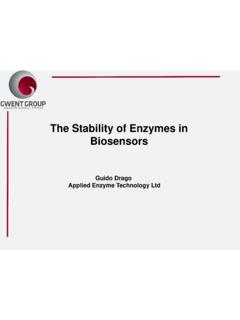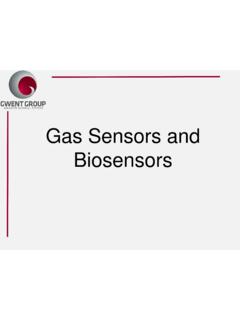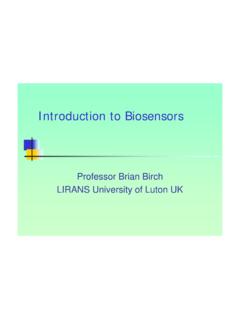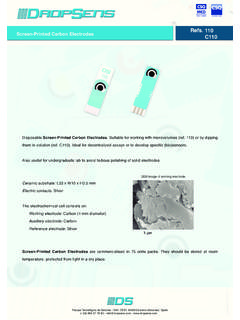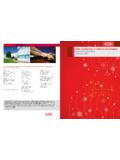Transcription of Electroluminescent Materials
1 Issue 2 March 2017 Electroluminescent Materials Issue 2 March 2017 Issue 2 March 2017 Electroluminescent Materials Overview. Product Range. GEM s products are based on a unique curing process that results in the low temperature formation of a thermosetting polymer that combines good adhesion to ITO and flexible substrates with excellent chemical, environmental and abrasion resistance. As a result of the improved environmental protection conferred by the inks the working life of most lamps can be improved. Phosphor Inks Product Code Number Blue/Green Phosphor Ink C2061027P13 Green Phosphor Ink C2070209P5 Blue Phosphor Ink C2061027P15 Orange Phosphor Ink C2070126P4 White Phosphor Ink C2070126P5 Blue/Green & Blue Phosphor Ink C2080211P2 Insulation/Dielectric Inks White Dielectric Ink D2070209P6 Pink Dielectric Ink D2090130P5 Conductor Inks Carbon Conductor Ink C2050503P1 Silver Conductor Ink C2131014D3 Binder Vehicle for Phosphors Polymeric Binder R2070613P2 ITO Film F2071018D1 Issue 2 March 2017 Introduction Demand for innovative lighting technology has been met with the development of Electroluminescent Materials .
2 Although luminescent have always been associated with the natural world, recent technological advancements have enabled luminescent Materials to become readily available for commercial use. Why Gwent Electronic Materials ? Gwent Electronic Materials (GEM) is a major supplier in electrochemical industry. One of our development projects has lead to the creation of an Electroluminescent Materials range. These Materials have been specifically designed to have a variety of applications. GEM s background in polymer thick film inks means that we have a firm base of organic binder technology and powder dispersion techniques on which to base our formulations.
3 GEM supply inks which are required to make Electroluminescent lamps by screen printing. These inks are designed to be used without adjustment; if you require specific properties in an EL ink we can tailor inks to your requirements. GEM also offers a full screen printing service, the combination of our company s extensive experience of screen printing and our Electroluminescent range enable us to produce an outstanding finished product. Gem prides itself on high standards and quality we have obtained:- Issue 2 March 2017 Key features Thin, flexible and lightweight. Print intricate designs. Screen printable. Highly resistant to aging and atmospheric effects.
4 Perform well under humid conditions. Exceptionally low heat generation. Resistant to impact and vibration. Low power consumption. Long life. Applications Electronic equipment Watches Toy and games Mobiles Palm computers Remote controls. Advertisement Safety and animated signs Unique lighting. Lighting for interior and exterior purposes Emergency illumination Backlights. Architecture and Decorative purposes. Customisation of clothes and accessories. Issue 2 March 2017 Our Electroluminescent Display Materials Compatible with ITO sputtered coated polyester film Transparent coated flexible substrates. Our unique heat curable inks Cross-link at low temperature (130 C) to form coherent coatings.
5 Excellent chemical and water resistance. Exceptional adhesion. Flexibility Have high conductivity bus bars, tracking and connections Our Silver inks with ITO, PET insulator and dielectric compatibility. Our products exhibit Excellent hardness Flexibility for display applications. Cross-linking inks, which can be used to attach terminals. Rear electrodes and for lower cost applications GEM s Carbon ink is suitable for the rear electrode on the surface of the dielectric layer. This ensures that possible humidity and migration effects are avoided, this can occur with silver conductors in poorly encapsulated systems in harsh environments.
6 To Protect from Humidity and physical effects (by encapsulating it with flexible insulator) Using the same stable organic system as the insulating material , the dielectric contains dispersed Barium Titanate to form the high dielectric constant layer. We supply a complete system of top of the range Phosphor inks with high brilliance and long life, to push the technology to new limits. The combined use of the latest phosphor technology with our innovative resin technology enhances our system of Electroluminescent Materials . Issue 2 March 2017 Building Sequence A polyester film with an indium tin oxide (ITO) spluttered coating or a screen printed translucent ink with good conductivity on a clear base substrate.
7 The printing of an Electroluminescent lamp on polyester consists of: 1. The front Bus bar, this is usually a silver ink which needs to be printed and cured. If the design is based using an ITO spluttered polyester the bus bar needs to be printed on the ITO side. 2. Phosphor is the next layer which is printed. Depending on the chemistry of the phosphor a range of colours can be emitted. It is vital for this layer to be dispersed evenly across the electrode. 3. Dielectric insulator, barium titanate dielectric insulating layer, the thickness of this layer depends on insulating requirements. 4. Rear electrode needs to be printed to match the inner edge of the bus bar, this can be either a silver or a carbon ink.
8 This sequence can be reduced to four stages, with a careful design we are able to combine printing of the front bus bar and the rear electrode (steps 1 and 4). Issue 2 March 2017 Typical Constructions Involves one of the methods outlined below:- STANDARD BUILD REVERSE BUILD Electroluminescent Display Inks Issue 2 March 2017 Electroluminescent Inks can be screen printed onto plastic sheets to form illuminated panels. These thin, lightweight panels can be cut and formed into various shapes to give truly flexible illumination. The panels are vibration and impact resistant, generate minimal heat in operation and have low power consumption.
9 The EL lamps which are formed from these panels are used in a variety of applications including backlighting in portable consumer electronics, telecommunications equipment, instrument panel illumination, information and advertising. Issue 2 March 2017 Electroluminescent Lamps The EL lamp is a parallel-plate lossy capacitor an active Electroluminescent phosphor is embedded in dielectric. Application of an AC voltage to both plates generates a changing field within the active layer, this causes the phosphor to emit light. The EL lamp is constructed from various layers of screen printed Polymer Thick Film ink compositions.
10 An EL lamp requires 60 -250V AC, and frequency range from 50-1000Hz. Brightness of the lamp can be increased by a higher voltage and frequency, however both these will shorten the life of the lamp. (Above: EL Lamp using Phosphor Blue C2061027P15) Typical Operating Voltage 100-120V AC RMS, recommended for most applications. 60 --250V AC RMS, (minimum maximum). Within the operating range, brightness obtained has a close proportional link to the square of the RMS voltage. For example to achieve an approximate quadrupling of the brightness of an EL lamp, you will need to double the RMS voltage.

